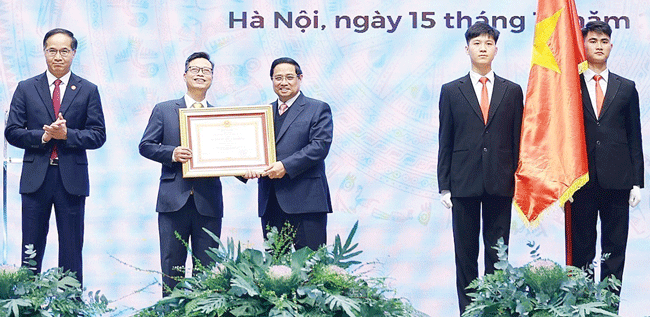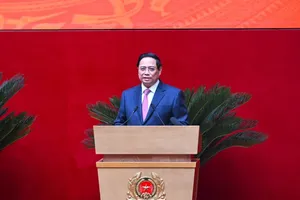
The connecting route project between Vo Van Kiet Avenue and the HCMC – Trung Luong Expressway was once highly anticipated to alleviate traffic congestion on National Highway No.1 at the western gateway of HCMC and complete the transportation network in the western and southern parts of the city. However, the project was launched in October 2015 under the charge of Yen Khanh JSC. (the investor) and HCMC-Trung Luong BOT Investment One-membered Co. Ltd., and after implementing approximately 12 percent of the total investment, has been stagnant since 2019.
On-site observations reveal that only one curved lane adjacent to Vo Van Kiet Avenue - National Highway No.1 has been partially completed before being abandoned for years. The project site is marred by abandoned structures, overgrown vegetation, and unresolved land issues. The lack of maintenance has led to the deterioration of infrastructure, with steel and metal components succumbing to the elements.
After three years of construction, the project has only achieved a total construction output of VND140 billion (US$5.5 million), equivalent to 12 percent of the total investment of VND1.56 trillion ($61.4 million), despite the project deadline having passed. This prolonged delay has caused significant inconvenience to local residents and wasted valuable resources.
According to the inter-departmental task force’s report, the HCMC Transport Department has repeatedly initiated coordinated efforts with relevant departments to work with the investor and project company to guide the rectification of contract violations in the signed BOT agreement. The HCMC Transport Construction Investment Project Management Board has also frequently engaged and issued multiple documents requesting the investor and project enterprise to report on project implementation status, legal matters, and documentation for completed work volumes.
However, after the above companies had repeatedly requested extensions and project timeline prolongations as well as their failure to meet contract obligations and to substantiate the value of completed project work, the HCMC People's Committee issued a unilateral notice terminating the BOT contract with both as the two entities have seriously violated the signed BOT contract.
HCMC plans to convert the project into a public investment for the remaining work to expedite the project’s completion. The project is expected to help solve traffic congestion on the vital expressway connecting HCMC to the Mekong Delta. The HCMC Department of Transport plans to connect the section to the HCMC Ring Road 3, instead of only to the HCMC-Trung Luong Expressway.

Another problematic traffic infrastructure project is the 2.7-kilometer connecting route from Pham Van Dong Street to Go Dua – National Highway No.1 Intersection in Thu Duc City of HCMC as a part of HCMC Ring Road 2. The project has an investment of over VND2.7 trillion ($106.3 million).
Despite the groundbreaking ceremony in late 2017 and the completion of approximately 44 percent of the work volume, construction has been halted since March 2020 due to land clearance and contract payment issue. Inside the construction site, abandoned vehicles like trucks and excavators had rusted and deteriorated due to prolonged exposure to the elements. The concrete mixing plant stood idle. The primary reasons for the stoppage were difficulties in land acquisition and compensation, as well as changes in regulations governing build-operate-transfer (BOT) investments.
According to the HCMC Department of Transport, the most urgent task is to revise the project’s feasibility study. This revision will involve determining a financing plan and supplementing compensation costs to finalize negotiations and amend the BOT contract with the investor. The municipal Department of Natural Resources and Environment is currently seeking guidance from its Ministry regarding the payment of land funds to the investor.
To proceed with the project, the Department of Transport has requested that the HCMC People's Committee instruct relevant departments to guide the investor in preparing the revised feasibility study report. The project’s completion date has been extended to 2026.
The delays in resolving project-related issues have obviously resulted in significant resource waste, including lost time, increased costs due to inflation, and a missed opportunity to develop the transportation infrastructure.
In November 2016, the HCMC People’s Committee signed BOT contract No.6827HD/UBND with a joint venture comprising HNS Vietnam Investment JSC., Van Phu Invest JSC., and Bac Ai Construction Investment Consulting JSC. to invest in and construct the section connecting Pham Van Dong Street to the Go Dua Intersection - National Highway No.1 Intersection in Thu Duc City under the public-private partnership model with a build-transfer (BT) contract.
The HCMC People's Committee will use land funds to pay the investor a total of over VND2.77 trillion ($109 million), including over VND944 billion ($37.2 million) for construction costs and over VND1.82 trillion ($71.6 million) for land clearance costs.
HCMC Ring Road 2 was planned in 2007 with a total length of 64km and designed to accommodate 6-8 lanes. This route commences from Nguyen Van Linh Street in Binh Chanh District, traverses the Phu My Bridge in District 7, continues to Binh Thai Intersection, then connects to Go Dua Intersection in Thu Duc City. The route culminates at National Highway 1 before looping back to Nguyen Van Linh Street.
However, after 16 years, only 50km of the entire route has been completed. The four unfinished segments:
- Segment 1 from the Phu Huu Bridge to Vo Nguyen Giap Street (Binh Thai Intersection) is 3.5km long;
- Segment 2 from Vo Nguyen Giap Street (Binh Thai intersection) to Pham Van Dong Street is 2.5km long;
- Segment 3, extending over 2.7km, runs from Pham Van Dong Street to Go Dua Intersection;
- Segment 4 is approximately 5.3km long from National Highway 1 to Nguyen Van Linh Street
























